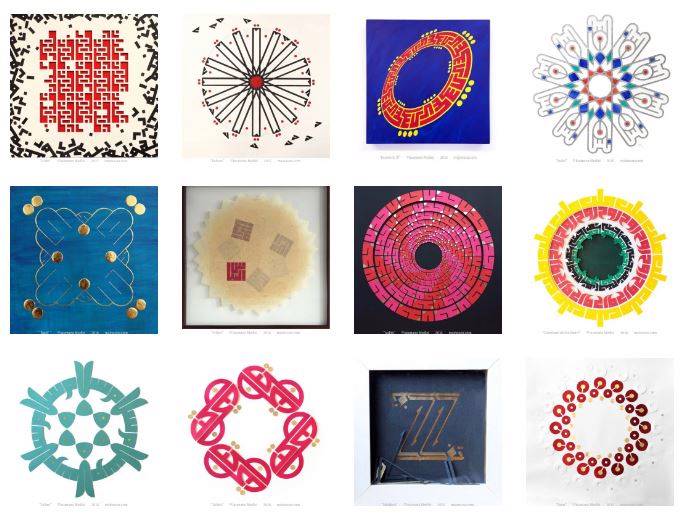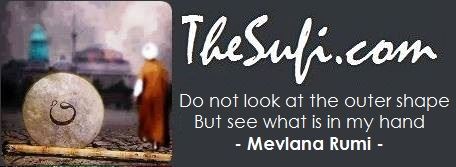TheSufi.com interviews Joumana Medlej, our favourite Kufic artist
In recent times, we have seen some amazing new talent in the field of Islamic Art and Calligraphy. However, when it comes to Kufic calligraphy and Kufic Square art, Joumana Medlej outshines this space with her modern approach to this elegant script. We discovered her art in 2019 and has been a fan since. So without further adieu, let’s find out more about the artist and her works…
10 Questions for Joumana Medle
1. You completed your formal education in art and Thesis / Dissertation at the University?
2. You were chosen a protégé by master calligrapher Samir Sayegh at Beirut. Tell us about your experience?
That was quite magical. From the way he chose me to help him with his work, to the work sessions in his workshop (to the sound of anything from Japanese flute to Phillip Glass) punctuated by long tea breaks during which he would tell me stories (from Sufi stories to stories of himself and his artist friends before the war). I mostly listened: he told me once I had the gift of silence! We keep up the tradition, as whenever I go back to Beirut he is the first person I visit, and we still sit and talk for hours around a cup of tea. During these years I didn’t realise I was undergoing a traditional apprenticeship, where you learn by doing what you’re asked, and gradually move to increasingly complex and important tasks until you are ready to stand on your own feet. It was probably not consciously intended in that way, but that’s what it was – he and I are both receptive to the mystery of how these things happen – and though my work today follows its own path, I’m aware of carrying on what he began, and that is humbling. By the way, even after all these years of closely working together and sharing private thoughts, I have never used his name – I still call him “ustadh”.

The ones I haven’t been able to visit (yet)! Ispahan, Samarqand, Herat, Granada even! My area of study and inspiration revolves around the Kufic script and early Islamic art, and there are so many sites of interest there I long to visit.
Truth Without Form started as an illustration for a German edition of Sufi sayings (Jahreszeiten der Liebe, 2014) and I felt its expressive potential deserved a large canvas. I deconstructed the word haqq intoits two component letters and made into the same silhouette. They are scattered widely on a background with which they blend, but a hidden form can be guessed behind the apparent randomness, and looking at an angle (a change of perspective) makes the letters appear sharply as their golden edges are revealed. It’s a very subtle piece. Himma on the other hand is very dazzling. It describes a quite complicated concept that I would boil down as “ spiritual aspiration and the creative energy it generates”. I like this quote by Henri Corbin: “When in contemplating an image, an icon, others recognize and perceive as a divine image the vision beheld by the artist who created the image, it is because of the spiritual creativity, the himma, which the artist put into his work.” The piece is a kingfisher blue, as I had a dream involving this bird while planning the piece. In strong light, the kingfisher blue achieves full intensity and sparkle, while the shadows are sharp, but in lower light that becomes dark and shadowy while the lighter blue shimmers gently as if with an inner light.
5. For budding Islamic artists especially in UK, what school and guidance you recommend to learn Kufic art?
I teach Manuscript and Square Kufic (and hopefully in the future other styles) at the Arab British Centre, although of course right now all in-person classes are suspended. The Prince’s school of Traditional Art also has a couple of Kufic courses (Square and Fatimid I believe). But Kufic is not properly taught anywhere. The lineage of teaching was broken long ago. To my knowledge I’m the only one working on bringing it back as a holistic tradition and certainly the only calligrapher completely specialised in Kufic with no retroactive influence from the later styles.
6. There are so many artisan calligraphers in Asia who don’t have exposure to ecommerce websites like Etsy.com. Is there advise you give them how to market and sell their artefacts?
Etsy is overrated and I can’t recommend it. I’m leaving it myself, it’s become completely commercial and not a good place for artists or artisans. If you can build a WordPress website and install Shopify (it’s not free but there is a Lite plan that is quite affordable), in my opinion that is the best thing you can do – then you can promote your own website and have your own shop on it instead of sending people to a third-party website. Third-party websites will always eventually let you down and hold you hostage with algorithms. They also keep you in constant comparison with other sellers with lesser yet cheaper wares. Build your own identity and promote that, you’ll come across as much more professional and unique. In my experience, the smaller number of visitors is compensated by the fact they’re happy to pay more for what is uniquely yours.
7. Do you plan to expand into other Islamic art forms like doing Kufic Tile Making or Pottery in the future?
No, I’m actually reducing the number of forms I practice as I prefer to do one thing really well than dabble in too many. But collaboration with ceramicists or other artisans is always possible!
8. Tell us about your ongoing and future projects and commissions that you are excited about.
I have just completed a groundbreaking book, Inks & Paints of the Middle-East, that is a handbook of Abbassid art technology. I need to recover from the effort and then return to my Kufic research. At the same time, I have some new artistic ideas to develop and that requires peace and an empty mind, so I’m heading to the countryside soon to find some focus. There is always so much more to do than there is time!
9 Do you offer any online course for students across the globe who may not have access to Arab British Centre in London?
I don’t as yet, it’s in the making but it’s so much more complicated, for the material I teach (an entire calligraphic system), than doing it in person. It’s been very difficult to find the time and there’s always something more urgent getting in the way. I’ve been putting together videos to integrate with a Zoom class but I wish I could just do a book, which is a format I’m much more comfortable with! In any case the intention is definitely firmly there and I hope I can set everything else aside and get some kind of remote teaching ready before the summer ends.
10. Tell us how your arts fan can keep in touch with your work?
All works of Joumana Medlej are her Intellectual Property and reproduced for illustration purpose only for her interview.



